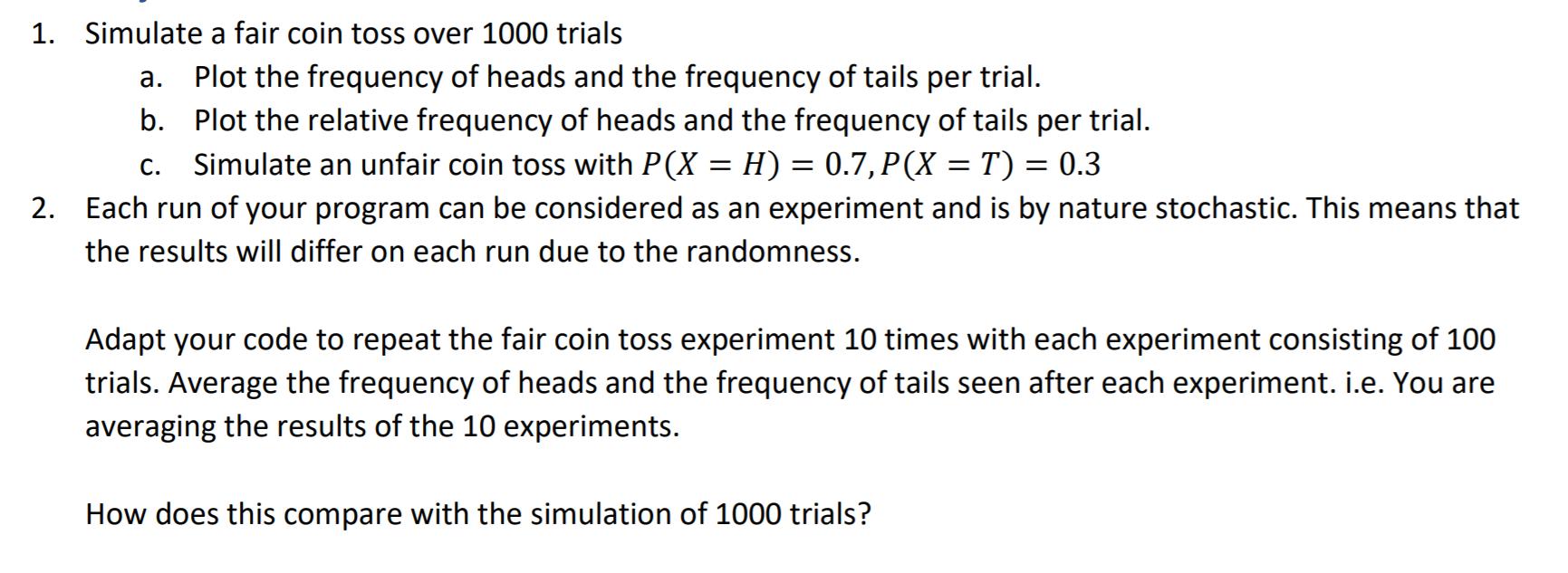Answered step by step
Verified Expert Solution
Question
1 Approved Answer
1. Simulate a fair coin toss over 1000 trials Plot the frequency of heads and the frequency of tails per trial. b. Plot the

1. Simulate a fair coin toss over 1000 trials Plot the frequency of heads and the frequency of tails per trial. b. Plot the relative frequency of heads and the frequency of tails per trial. c. Simulate an unfair coin toss with P(X = H) = 0.7, P(X = T) = 0.3 . 2. Each run of your program can be considered as an experiment and is by nature stochastic. This means that the results will differ on each run due to the randomness. Adapt your code to repeat the fair coin toss experiment 10 times with each experiment consisting of 100 trials. Average the frequency of heads and the frequency of tails seen after each experiment. i.e. You are averaging the results of the 10 experiments. How does this compare with the simulation of 1000 trials? 1. Simulate a fair coin toss over 1000 trials Plot the frequency of heads and the frequency of tails per trial. b. Plot the relative frequency of heads and the frequency of tails per trial. c. Simulate an unfair coin toss with P(X = H) = 0.7, P(X = T) = 0.3 . 2. Each run of your program can be considered as an experiment and is by nature stochastic. This means that the results will differ on each run due to the randomness. Adapt your code to repeat the fair coin toss experiment 10 times with each experiment consisting of 100 trials. Average the frequency of heads and the frequency of tails seen after each experiment. i.e. You are averaging the results of the 10 experiments. How does this compare with the simulation of 1000 trials? 1. Simulate a fair coin toss over 1000 trials Plot the frequency of heads and the frequency of tails per trial. b. Plot the relative frequency of heads and the frequency of tails per trial. c. Simulate an unfair coin toss with P(X = H) = 0.7, P(X = T) = 0.3 . 2. Each run of your program can be considered as an experiment and is by nature stochastic. This means that the results will differ on each run due to the randomness. Adapt your code to repeat the fair coin toss experiment 10 times with each experiment consisting of 100 trials. Average the frequency of heads and the frequency of tails seen after each experiment. i.e. You are averaging the results of the 10 experiments. How does this compare with the simulation of 1000 trials?
Step by Step Solution
★★★★★
3.35 Rating (155 Votes )
There are 3 Steps involved in it
Step: 1
CODE a Fair coin tossing experiment defining Trials v...
Get Instant Access to Expert-Tailored Solutions
See step-by-step solutions with expert insights and AI powered tools for academic success
Step: 2

Step: 3

Ace Your Homework with AI
Get the answers you need in no time with our AI-driven, step-by-step assistance
Get Started


